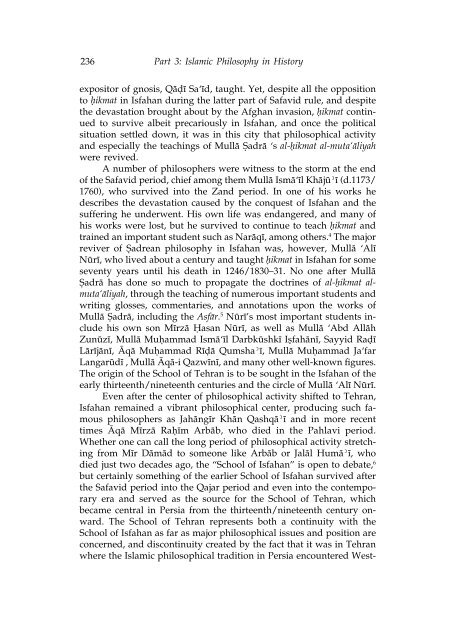Islamic Philosophy from Its Origin to the Present: Philosophy in the ...
Islamic Philosophy from Its Origin to the Present: Philosophy in the ...
Islamic Philosophy from Its Origin to the Present: Philosophy in the ...
Create successful ePaper yourself
Turn your PDF publications into a flip-book with our unique Google optimized e-Paper software.
236 Part 3: <strong>Islamic</strong> <strong>Philosophy</strong> <strong>in</strong> His<strong>to</strong>ry<br />
exposi<strong>to</strong>r of gnosis, Qå∂¥ Sa‘¥d, taught. Yet, despite all <strong>the</strong> opposition<br />
<strong>to</strong> ÷ikmat <strong>in</strong> Isfahan dur<strong>in</strong>g <strong>the</strong> latter part of Safavid rule, and despite<br />
<strong>the</strong> devastation brought about by <strong>the</strong> Afghan <strong>in</strong>vasion, ÷ikmat cont<strong>in</strong>ued<br />
<strong>to</strong> survive albeit precariously <strong>in</strong> Isfahan, and once <strong>the</strong> political<br />
situation settled down, it was <strong>in</strong> this city that philosophical activity<br />
and especially <strong>the</strong> teach<strong>in</strong>gs of Mullå |adrå ‘s al-÷ikmat al-muta‘åliyah<br />
were revived.<br />
A number of philosophers were witness <strong>to</strong> <strong>the</strong> s<strong>to</strong>rm at <strong>the</strong> end<br />
of <strong>the</strong> Safavid period, chief among <strong>the</strong>m Mullå Ismå‘¥l Khåj¨˘¥ (d.1173/<br />
1760), who survived <strong>in</strong><strong>to</strong> <strong>the</strong> Zand period. In one of his works he<br />
describes <strong>the</strong> devastation caused by <strong>the</strong> conquest of Isfahan and <strong>the</strong><br />
suffer<strong>in</strong>g he underwent. His own life was endangered, and many of<br />
his works were lost, but he survived <strong>to</strong> cont<strong>in</strong>ue <strong>to</strong> teach ÷ikmat and<br />
tra<strong>in</strong>ed an important student such as Naråq¥, among o<strong>the</strong>rs. 4 The major<br />
reviver of |adrean philosophy <strong>in</strong> Isfahan was, however, Mullå ‘Al¥<br />
N¨r¥, who lived about a century and taught ÷ikmat <strong>in</strong> Isfahan for some<br />
seventy years until his death <strong>in</strong> 1246/1830–31. No one after Mullå<br />
|adrå has done so much <strong>to</strong> propagate <strong>the</strong> doctr<strong>in</strong>es of al-÷ikmat almuta‘åliyah,<br />
through <strong>the</strong> teach<strong>in</strong>g of numerous important students and<br />
writ<strong>in</strong>g glosses, commentaries, and annotations upon <strong>the</strong> works of<br />
Mullå |adrå, <strong>in</strong>clud<strong>in</strong>g <strong>the</strong> Asfår. 5 N¨r¥’s most important students <strong>in</strong>clude<br />
his own son M¥rzå ¡asan N¨r¥, as well as Mullå ‘Abd Allåh<br />
Zun¨z¥, Mullå Mu±ammad Ismå‘¥l Darbk¨shk¥ I∑fahån¥, Sayyid Ra∂¥<br />
Lår¥jån¥, ≈qå Mu±ammad R¥∂å Qumsha˘¥, Mullå Mu±ammad Ja‘far<br />
Langar¨d¥ , Mullå ≈qå-i Qazw¥n¥, and many o<strong>the</strong>r well-known figures.<br />
The orig<strong>in</strong> of <strong>the</strong> School of Tehran is <strong>to</strong> be sought <strong>in</strong> <strong>the</strong> Isfahan of <strong>the</strong><br />
early thirteenth/n<strong>in</strong>eteenth centuries and <strong>the</strong> circle of Mullå ‘Al¥ N¨r¥.<br />
Even after <strong>the</strong> center of philosophical activity shifted <strong>to</strong> Tehran,<br />
Isfahan rema<strong>in</strong>ed a vibrant philosophical center, produc<strong>in</strong>g such famous<br />
philosophers as Jahång¥r Khån Qashqå˘¥ and <strong>in</strong> more recent<br />
times ≈qå M¥rzå Ra±¥m Arbåb, who died <strong>in</strong> <strong>the</strong> Pahlavi period.<br />
Whe<strong>the</strong>r one can call <strong>the</strong> long period of philosophical activity stretch<strong>in</strong>g<br />
<strong>from</strong> M¥r Dåmåd <strong>to</strong> someone like Arbåb or Jalål Humå˘¥, who<br />
died just two decades ago, <strong>the</strong> “School of Isfahan” is open <strong>to</strong> debate, 6<br />
but certa<strong>in</strong>ly someth<strong>in</strong>g of <strong>the</strong> earlier School of Isfahan survived after<br />
<strong>the</strong> Safavid period <strong>in</strong><strong>to</strong> <strong>the</strong> Qajar period and even <strong>in</strong><strong>to</strong> <strong>the</strong> contemporary<br />
era and served as <strong>the</strong> source for <strong>the</strong> School of Tehran, which<br />
became central <strong>in</strong> Persia <strong>from</strong> <strong>the</strong> thirteenth/n<strong>in</strong>eteenth century onward.<br />
The School of Tehran represents both a cont<strong>in</strong>uity with <strong>the</strong><br />
School of Isfahan as far as major philosophical issues and position are<br />
concerned, and discont<strong>in</strong>uity created by <strong>the</strong> fact that it was <strong>in</strong> Tehran<br />
where <strong>the</strong> <strong>Islamic</strong> philosophical tradition <strong>in</strong> Persia encountered West-

















